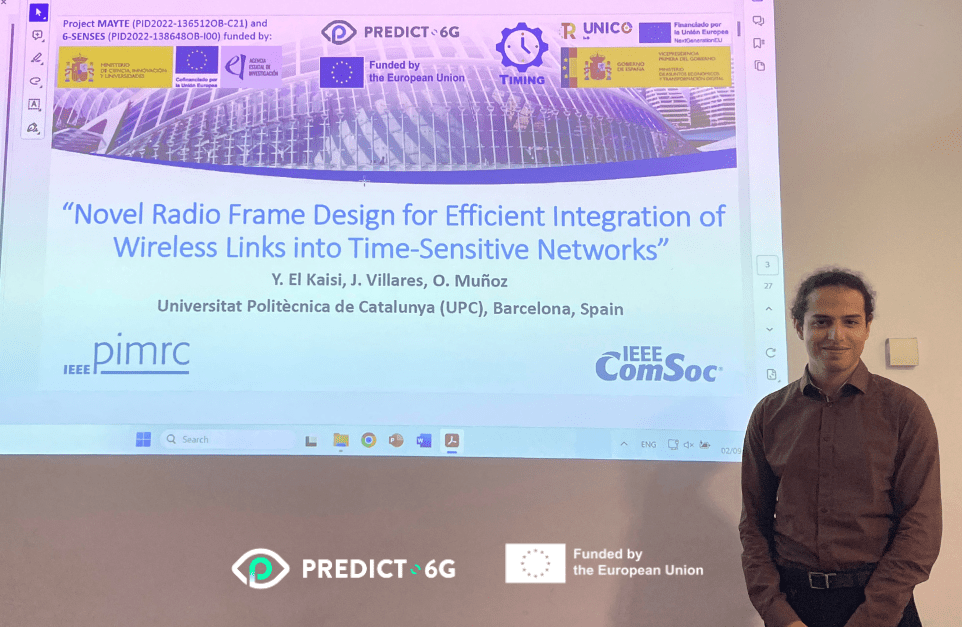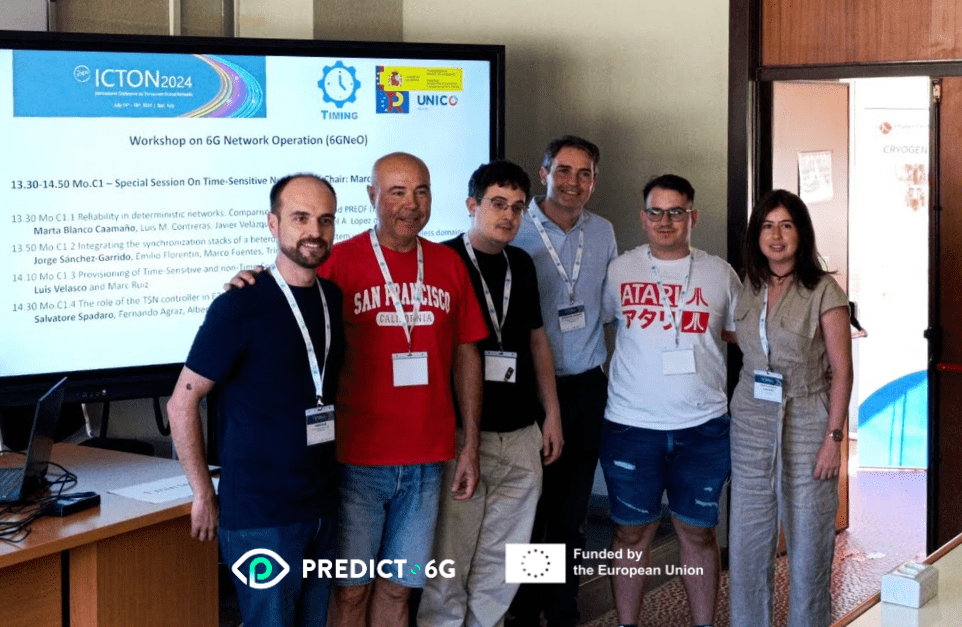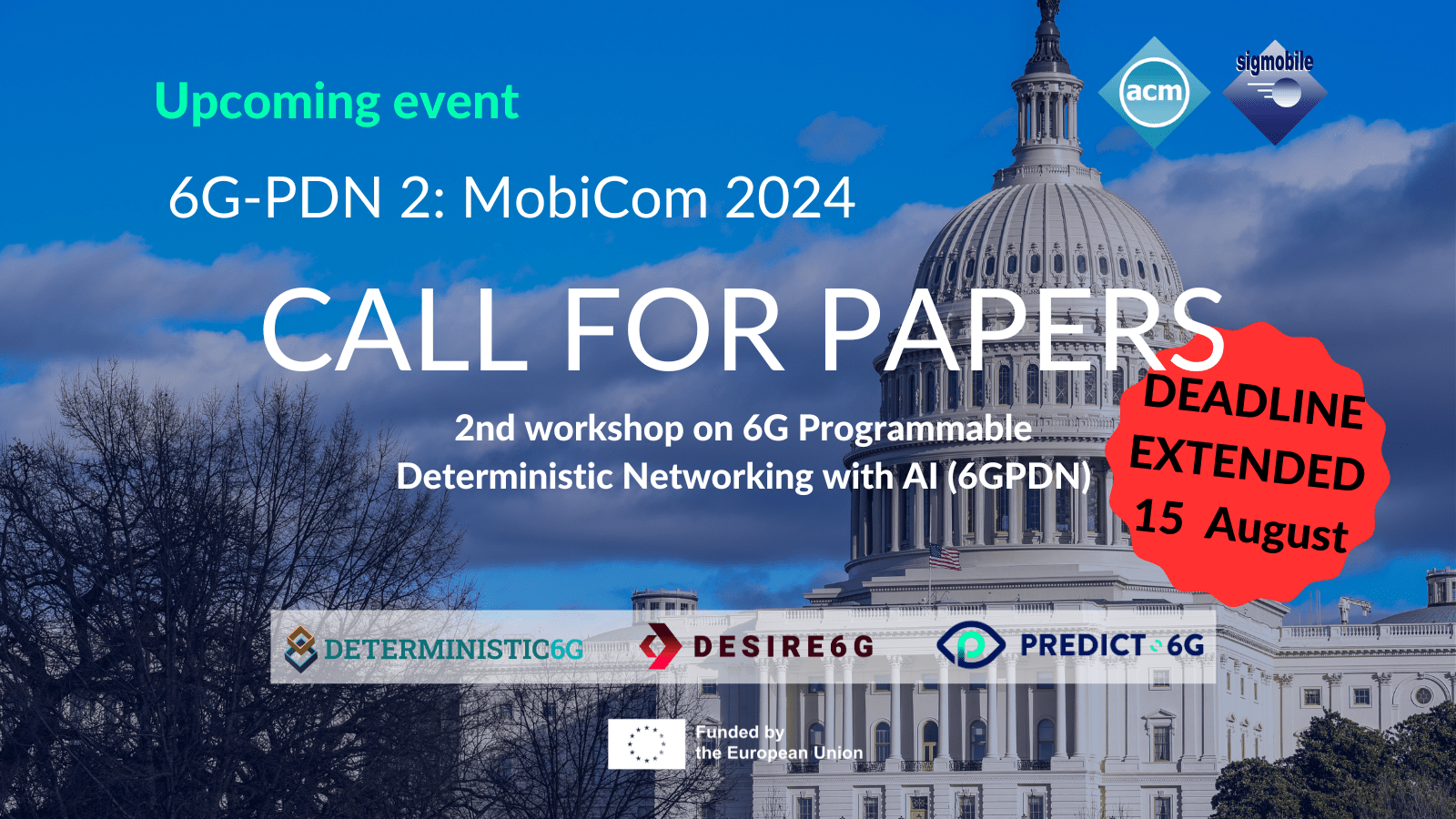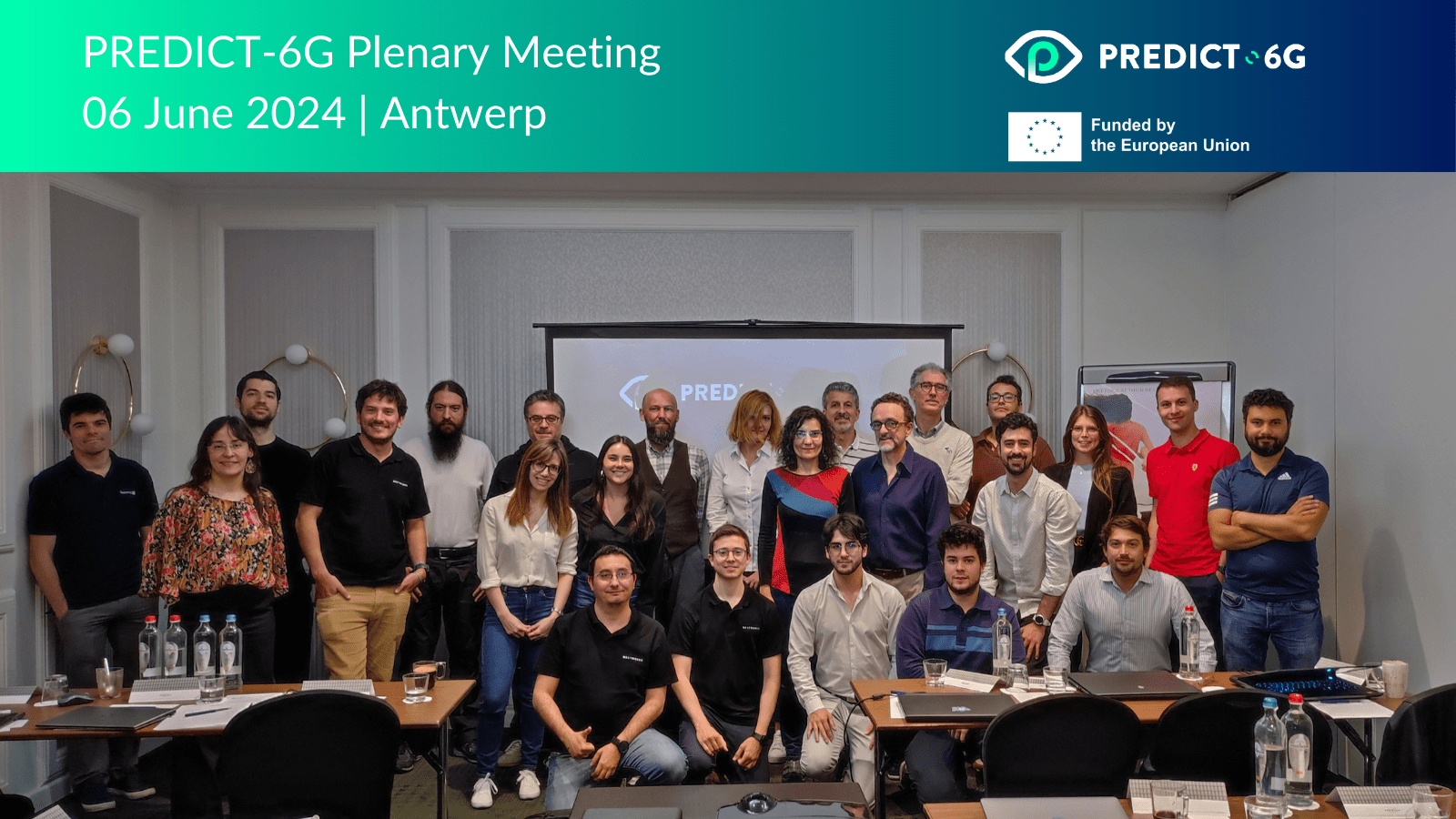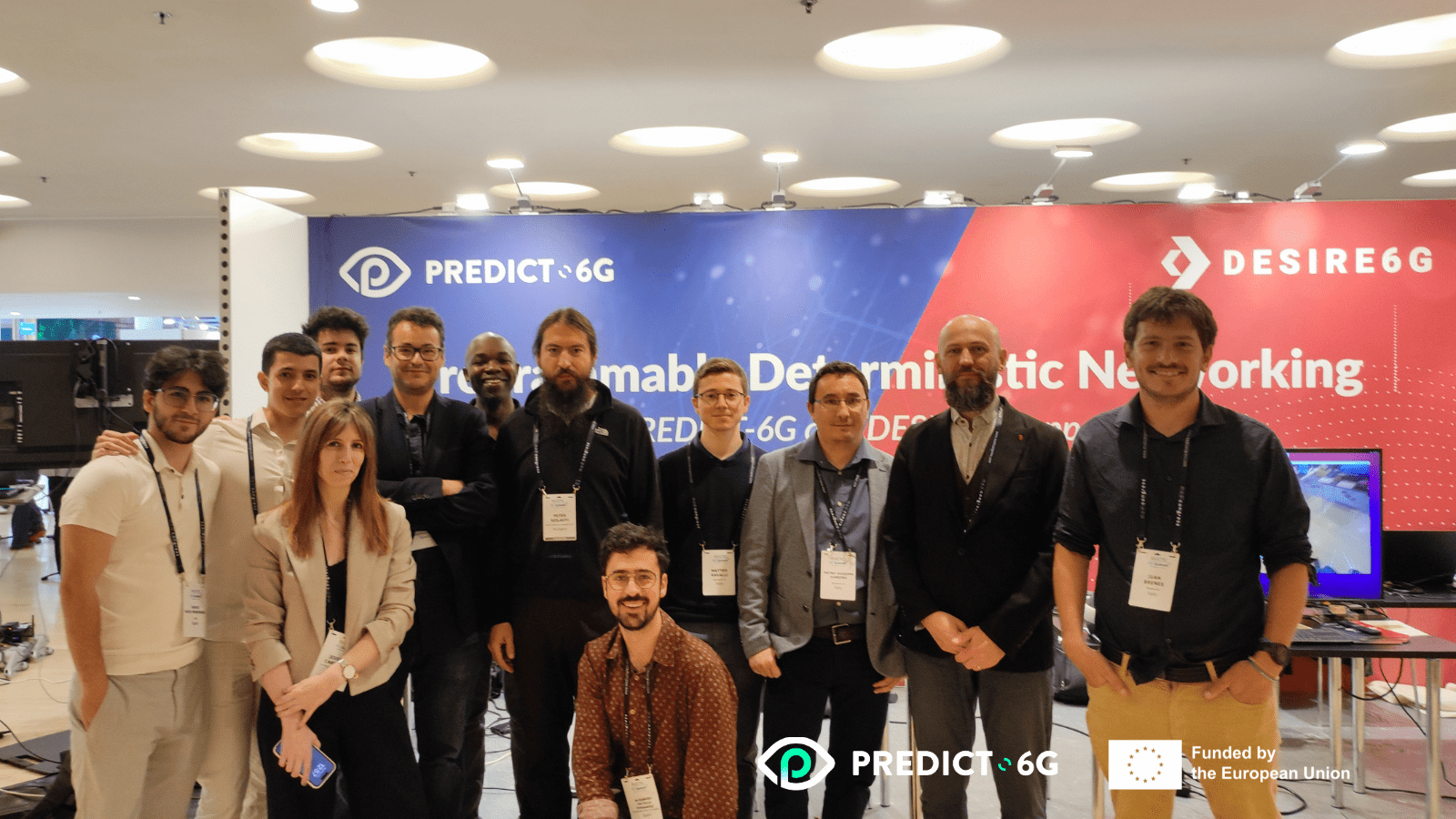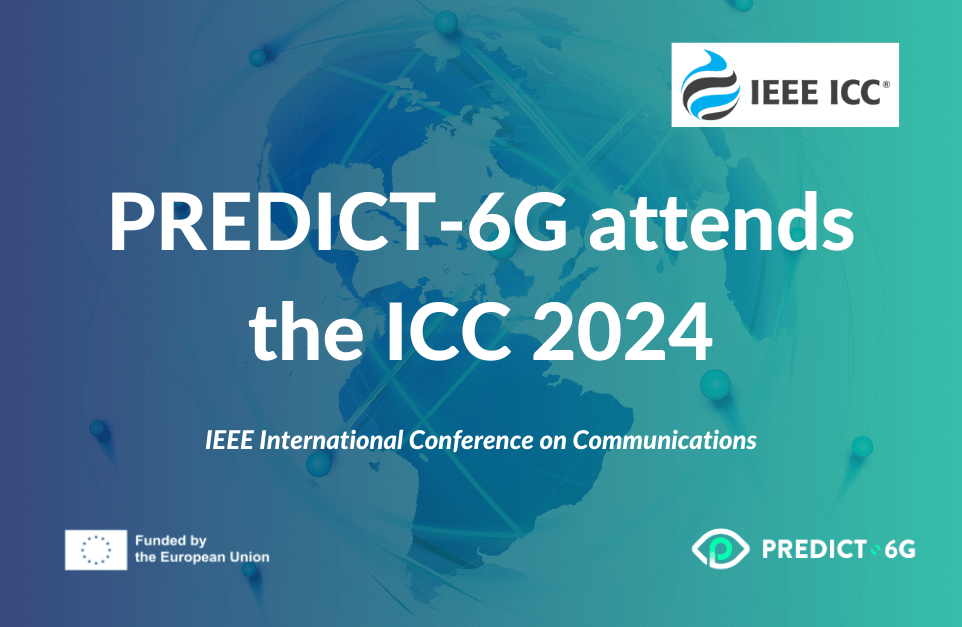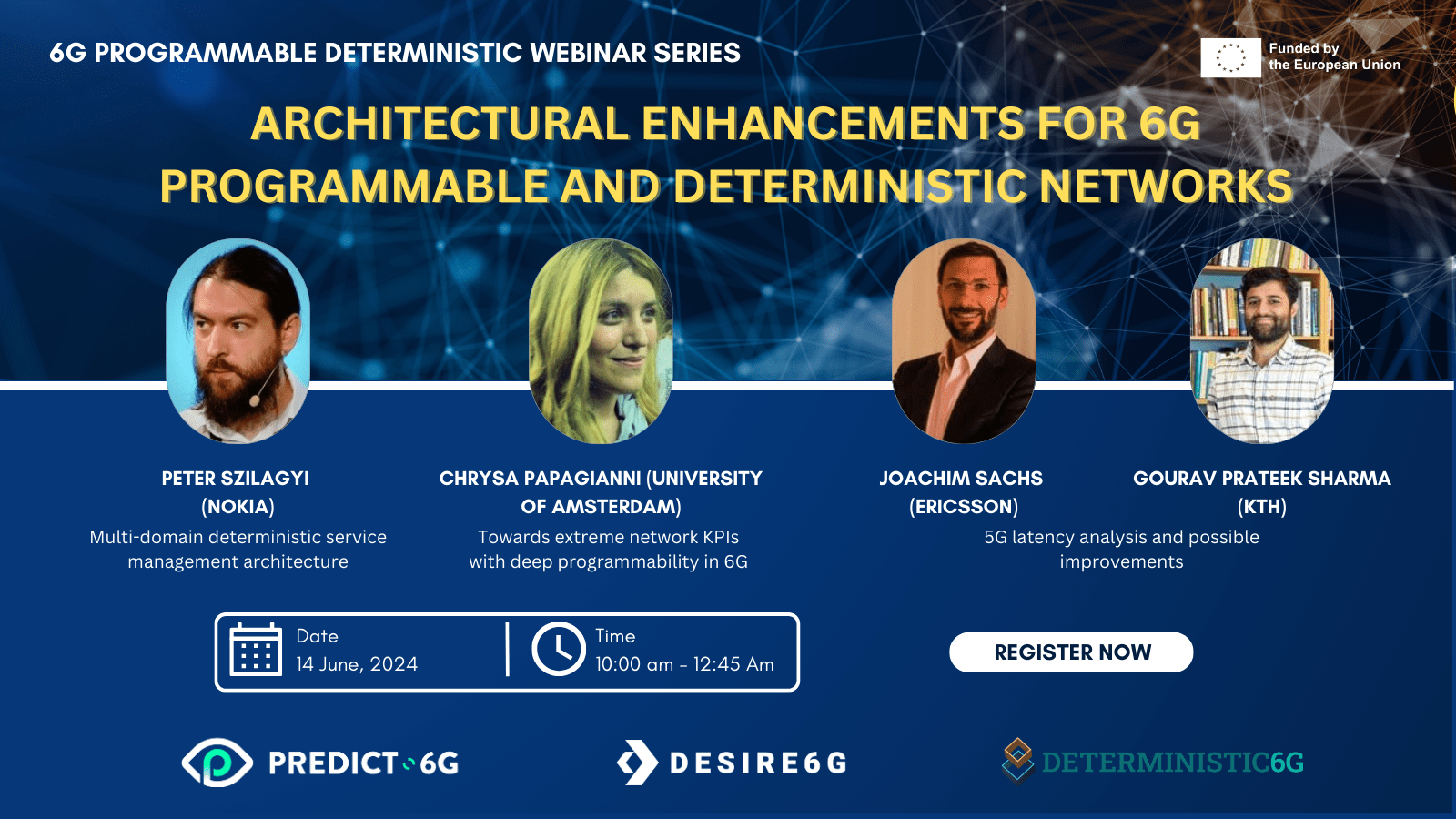PREDICT-6G at ETFA 2024
The 29th IEEE International Conference on Emerging Technologies and Factory Automation (ETFA) 2024 took place from 10 to 13 September 2024 in Padova, Italy. This conference brings together professionals from industry and academia to share cutting-edge concepts, recent developments, research results, and practical achievements in industrial and factory automation. The key goal is to foster the enhancement and application of scientific techniques, models, and tools that support the efficient design and operation of industrial and factory automation systems. Several PREDICT-6G partners were there to present work related to the project.
Pietro Giuseppe Giardina from Nextworks was invited to talk in the Industry Forum of the conference. In the talk, titled 'Bringing determinism in private mobile networks for Industry 5.0 scenarios: opportunities and challenges', he explained the benefits of adopting 5G/6G technologies in the industry and how the research can foster such an adoption with two example projects: PREDICT-6G and Zero-SWARM.
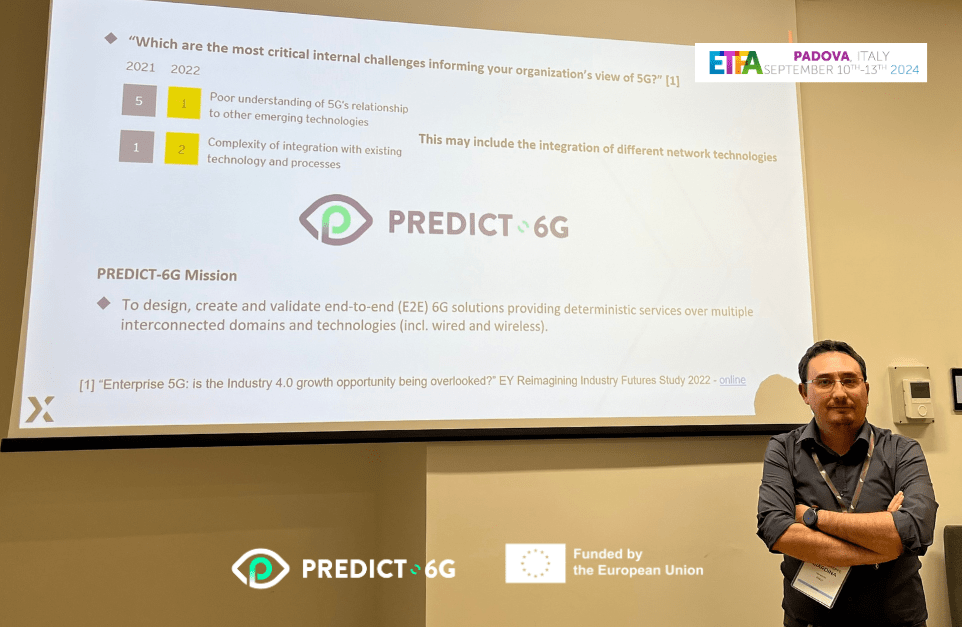
In the Technical Track “TSN in Industrial Systems”, Claudio Zunino, principal investigator of Consiglio Nazionale delle Ricerche (CNR), presented the paper ‘Time-Sensitive Networking and Software-Defined Networking: an experimental setup for realistic performances’. Written by the CNR, Intel, the University of Padova (all members of the PREDICT-6G consortium), and the University of Modena and Reggio Emilia, this paper investigates the integration between Time-Sensitive Networking (TSN) and Software-Defined Networking (SDN) to enable dynamic network re-configuration and improve performance for time-critical applications. The paper can be read and downloaded here.
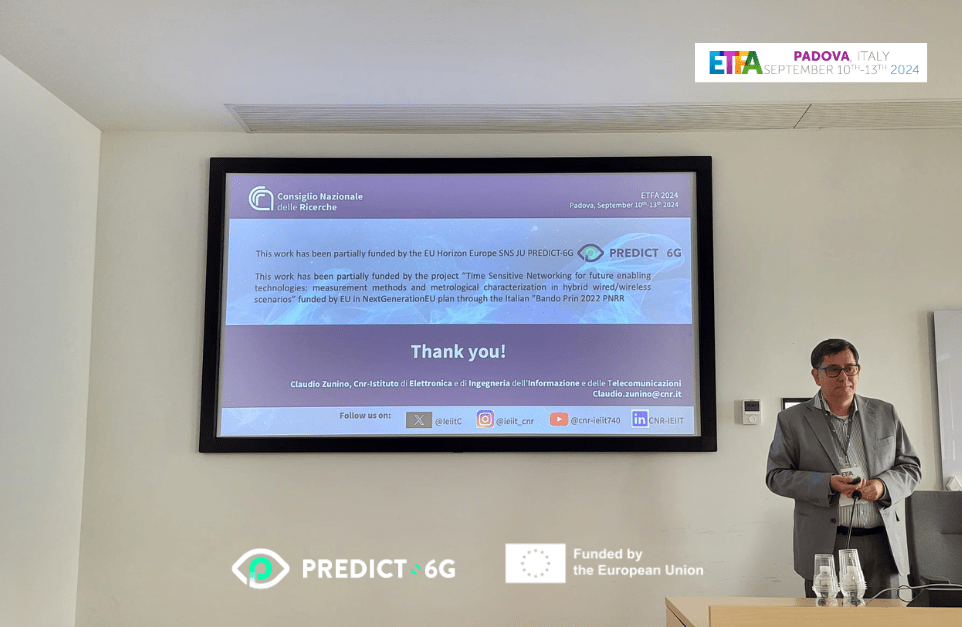
During the “Industrial Communication Technologies and Systems” session, Prof. Zunino presented the paper ‘IEEE 1588 (PTP) over mmWave 5G NR: preliminary assessment of the synchronization accuracy for TSN applications’ produced by PREDICT-6G partners CNR and the University of Padova, as well as by the University of Modena and Reggio Emilia. The paper discusses the extension of TSN to wireless domains for realising the Industry 4.0 and 5.0 applications. It focuses on the assessment of the synchronization accuracy of IEEE 1588 (PTP) over 5G NR networks.
Lastly, INTEL, CNR and the University of Padova presented the ‘Time-Sensitive Networking for Trajectory Tracking of an Unmanned Ground Vehicle over Wi-Fi’ paper in the Special Session - Exploring the limits of Time Sensitive Networking. Utilising the IEEE 802.1AS standard for wireless time synchronization, this study investigates the impact of clock synchronization errors and latency on trajectory tracking in a wireless network scenario involving an Unmanned Ground Vehicle (UGV). It demonstrates the capability and benefits of IEEE 802.1AS in managing device clocks and facilitating time correction to ensure precise trajectory tracking despite synchronization errors and latency.
If you want to stay updated about PREDICT-6Gt, subscribe to our newsletter and follow us on Twitter and LinkedIn!
IEEE International Symposium on Personal, Indoor and Mobile Radio Communications (PIMRC) 2024
IEEE International Symposium on Personal, Indoor and Mobile Radio Communications (PIMRC) took place on the 2-5 September 2024 in Valencia, Spain. Under the theme “Elevating 6G Beyond Connectivity”, PIMRC is one the flagship conferences for IEEE Communications Society with a special focus on cutting-edge wireless technology research and innovations. PREDICT-6G was represented by two consortium partners.
Universitat Politècnica de Catalunya attended PIMRC to present the paper 'Novel Radio Frame Design for Efficient Integration of Wireless Links into Time-Sensitive Networks' as part of the Workshop on Industrial Wireless Network. This paper presents a novel radio frame design for wireless links that enables the efficient scheduling of multiple time-sensitive flows with arbitrarily small packet jitter and delay requirements. The benefits of the approach described in the paper are numerically evaluated in an illustrative industrial scenario that shows a substantial gain in terms of both reduced control cycle (periodicity of flows) and improved transmission performance (number of supported flows).
The paper was presented during the conference by the student Youssef El Kaisi Rahmoun. It can be read and downloaded here.
Politecnico di Torino also attended PIMRC to present the paper ‘Target Wake Time Scheduling for Time-Sensitive Networking in the Industrial IoT’. In this paper, POLITO “demonstrate that Target Wake Time-Acceptance and Scheduling Problem-Efficient Resolver (TASPER) schedules traffic with up to 21.23% higher priority-weighted admission ratio and saves up to 7.42% energy compared to the ShortestFirst strategy, all while satisfying AoI constraints for 99.5% of transmissions”. It can be read and downloaded here.
If you want to stay updated about PREDICT-6Gt, subscribe to our newsletter and follow us on Twitter and LinkedIn!
PREDICT-6G at ICTON
The International Conference on Transparent Optical Networks (ICTON) 2024 was held from 14 to 18 July 2024 in Bari, Italy. It focused on applications of transparent and all-optical technologies to telecommunications, computing, sensing and quantum applications. Various PREDICT-6G partners attended the event.
Universitat Politècnica de Catalunya organised the 6G Network Operation (6GNeO) workshop as part of ICTON, with a special session on Time Sensitive Networking (TSN) and Deterministic Networking (DetNet). In this session, Telefónica Innovación Digital presented the paper ‘Reliability in deterministic networks: Comparison of FRER (TSN) and PREOF (DetNet)’, which was developed in the framework of PREDICT-6G.
“Telefónica showcased various techniques aimed at enhancing network reliability through the use of TSN and DetNet”, explains Marta Blanco Caamaño, first author of the paper and the person in charge of presenting the work at the 6GNeO workshop. The paper can be read and downloaded here.
If you want to stay updated about PREDICT-6Gt, subscribe to our newsletter and follow us on Twitter and LinkedIn!
PREDICT-6G at IEEE HPSR
The IEEE 25th International Conference on High Performance Switching and Routing (HPSR) was held 22-24 July 2024 in Pisa, Italy. The main focus of the HPSR 2024 was to assess how breakthrough changes occurring to networks and telecom are affecting areas related to switching and routing, and communication networks in general.
PREDICT-6G was represented by our consortium member Nextworks, which had a booth showcasing a poster and the screening of the demo jointly developed with InterDigital: “Monitoring Data collection Integration with a Sensing-Enabled 3GPP Technology Domain”. The demo presents a multi-domain monitoring data collection for the PREDICT-6G project. It automates the collection of Layer 4 latency and sensing data from a 3GPP domain, feeding it into an AI-driven control plane and a digital twin application. The demo integrates the AI-Driven Control Plane (AICP) to manage service provisioning and data monitoring. You can watch it here.
If you want to stay updated about PREDICT-6Gt, subscribe to our newsletter and follow us on Twitter and LinkedIn!
Upcoming events
PREDICT-6G is entering its last year and the consortium partners are showing the progress in the project, presenting the latest publications and papers in several events that will take place in the coming months. Here is a list so you do not miss any of them.
ICTON 2024
The International Conference on Transparent Optical Networks (ICTON) 2024 will be held from 14 to 18 July in Bari, Italy. The conference and side events will focus on applications of transparent and all-optical technologies to telecommunications, computing, sensing and quantum applications. Luis Miguel Contreras from Telefonica will present the paper “Reliability in deterministic networks: Comparison of FRER (TSN) and PREOF (DetNet)”, related to the research carried out within the project. The publication is available here.
PIMRC 2024
IEEE International Symposium on Personal, Indoor and Mobile Radio Communications (PIMRC) will take place 2-5 September in Valencia, Spain. Under the theme “Elevating 6G Beyond Connectivity”, PIMRC is one the flagship conferences for IEEE Communications Society with a special focus on cutting-edge wireless technology research and innovations. Professor Carla Fabiana Chiasserini from Politecnico di Torino will attend the conference to present the paper “Target Wake Time Scheduling for Time-SensitiveNetworking in the Industrial IoT”.
ETFA 2024
The 29th IEEE International Conference on Emerging Technologies and Factory Automation, (ETFA) 2024, will take place from 10 to 13 September in Padova, Italy. It brings together professionals from industry and academia to share cutting-edge concepts, recent developments, research results, and practical achievements in industrial and factory automation. The key goal is to foster the enhancement and application of scientific techniques, models, and tools that support the efficient design and operation of industrial and factory automation systems. PREDICT-6G consortium members, CNR and Intel will be at the Conference to present the paper “Time-Sensitive Networking and Software-Defined Networking: an experimental setup for realistic performances”.
IEEE HPSR
The 2024 IEEE 25th International Conference on High Performance Switching and Routing (HPSR) will be held 22-24 July in Pisa, Italy. The main focus of the HPSR 2024 will be to assess how breakthrough changes occurring to networks and telecom are affecting areas related to switching and routing, and communication networks in general. Nextworks, a member of the PREDICT-6G consortium, will be present at HPSR with a booth promoting the project with a poster and a screening of the joint demo with InterDigital: Monitoring Data collection Integration with a Sensing-Enabled 3GPP Technology Domain. You can watch the demo here.
If you want to stay updated about PREDICT-6G, subscribe to our newsletter and follow us on Twitter and LinkedIn!
Call for papers: MobiCom 2024
In the scope of the MobiCom 2024 -The Annual International Conference on Mobile Computing and Networking- which will be held on the 18-22 of November in Washington DC, DESIRE6G, DETERMINISTIC6G and PREDICT-6G will co-organise the 2nd workshop on 6G Programmable Deterministic Networking with AI (6G-PDN 2). In preparation for the workshop, the projects have launched a call for papers that contribute to the advancement of 6G network research.
The objective of this workshop is to discuss the roadmap and challenges in the technology areas of deterministic communications and deep network programmability in 6G to support future end-to-end time-critical applications. It also aims to bring together academic and industry researchers to stimulate discussions, introduce news ideas and technical solutions in the aforementioned areas and therefore contribute to the progress of 6G networking research.
Submitted papers may cover any of the following topics:
- Programmable data planes for TSN.
- Enhancements towards 6G TSN and DetNet integration.
- Network softwarization for 6G.
- Programmable networking protocols.
- Programmable SDN and NFV: languages and architectures (P4 and others).
- Hardware acceleration for programmable network functions.
- Multitenant data planes.
- Orchestration and management of software-defined deterministic networks.
- Control and management of data plane programmable devices.
- Artificial intelligence for deterministic networks.
- In network machine learning.
- In-network service level tuning and optimization; QoS.
- High precision traffic monitoring/telemetry.
- Service assurance and fulfilment programmability.
- Slicing for 6G.
- Intent-based systems and digital twinning applied in 6G.
- Routing and scheduling algorithms for reliable and real-time IoT.
- Trustworthy edge and cloud computing architectures and services.
Paper Submission deadline is August 15, 2024
You can read all the detailed information here.
If you want to stay updated about PREDICT-6G, subscribe to our newsletter and follow us on Twitter and LinkedIn!
PREDICT-6G's plenary meeting in Antwerp
On the 6th of June, the PREDICT-6G Consortium gathered for its first plenary meeting of 2024 in Antwerp, Belgium.
Taking advantage of PREDICT-6G's presence at the EuCNC & 6G Summit, which took place in Antwerp from 3-6 June, the consortium decided to hold a one-day plenary meeting. This is the first plenary meeting of 2024, just after the mid-term review of the project with the European Commission and almost a year and a half after the start of the project, a date that undoubtedly marks a turning point between what PREDICT-6G has achieved so far and what we want to achieve by the end of it.
The meeting was very productive. The consortium reviewed the status of the work packages, with particular emphasis on those that by their technical nature constitute the core of PREDICT-6G. The integration of the feedback received during the mid-term project review was also further discussed, which together with the exchanges in the plenary meeting about various aspects of the work ahead, yielded a clear roadmap for the last year of the project.
The PREDICT-6G consortium will meet again in the autumn to further advance the common goal of creating a secure, modular, interoperable, and extensible 6G deterministic network.
If you want to stay updated about PREDICT-6Gt, subscribe to our newsletter and follow us on Twitter and LinkedIn!
2024 EuCNC & 6G Summit
The 2024 EuCNC & 6G Summit took place from 3 to 6 of June in Antwerp, Belgium. Bringing together cutting-edge research, trailblazing innovators, and world-renown companies, the event has become a reference in the telecommunications sector. Over 50 exhibitors and 900 participants across 40 countries attest to the relevance of the conference.
PREDICT-6G was determined to repeat the 2023 success in this new edition. A delegation comprising team members from different consortium partners arrived in Antwerp, ready to support the different project activities and to share and discuss the developments of the past year. Project members attended the numerous keynotes, panels, sessions, and tutorials, whilst seizing the networking opportunities during the social activities included in the programme.
The first day of EuCNC began with the set-up of the “Programmable deterministic networking: the PREDICT-6G and DESIRE6G approaches' booth. Co-organised by PREDICT-6G and DESIRE6G, it hosted various demos: “Target Wake Time” by Politecnico di Torino (POLITO), “Smart Factory” by Gestamp and Ericsson, and “Monitoring Data Collection Integration with a Sensing-Enabled 3GPP Technology Domain'' by Nextworks and InterDigital.
“Sancho”, the robot dog starring in the “Real-time Gesture Based Remote Control of a Digital Twin” demo (UC3M), drew a lot of attention from the public. Visitors were invited to experience first-hand how Sancho performs the different commands given to it through gestures that are registered by a camera placed on site and then transmitted.
The “Experimentation in a wireless multi-domain deterministic network” poster by UC3M and Intel was also displayed in the booth. It details the design, development, and performance of single domain solutions to support multi-domain deterministic networking, integrating IEEE 802.11, IEEE 802.1 TSN, and 3GPP 5G over an IETF DetNet overlay.
“EuCNC is a great opportunity not only to show our own work to the event participants, but also to interact with other projects’ members to share ideas and to learn something from each other. PREDICT-6G project attracted a lot of interest for the challenges it faces: many demos and explanations about the system architecture and capabilities were requested at the booth, thus making the team proud for their efforts and honoured to work in such an environment for the project purpose.” said Matteo Ravalli (Nextworks).
PREDICT-6G also participated in three workshops. Prof. Antonio de la Oliva (UC3M), PREDICT-6G coordinator, delivered a presentation in the “The 6G series workshop by Hexa-X-II”. Dr. Sebastian Robitszch (InterDigital), chair of PREDICT-6G Standardisation Advisory Board, moderated the “Architectural Considerations Enabling the IMT 2030 Framework by European 6G R&D Activities” workshop. Lastly, Valerio Frascolla (INTEL), PREDICT-6G innovation manager, delivered a presentation in the “Trials, Pilots and Demos for Selected Verticals: the Experimental Way Forward towards 6G” workshop.
The PREDICT-6G communication efforts during the EuCNC & 6G Summit, led by AUSTRALO, were recognised with the “Best Social Media Presence Award”. This honour acknowledged the long-term commitment of the project with the communication and dissemination of its activities and outcomes to the large public.
The participation of PREDICT-6G was a great success. The project team exchanged with other SNS projects, researchers and experts about the current hot topics and the upcoming trends. Furthermore, it promoted the work carried out in the past year and a half in various areas of the project.
The 2024 EuCNC & 6G Summit is sponsored by the IEEE Communications Society (ComSoc), the European Association for Signal Processing (EURASIP) and the European Association on Antennas and Propagation (EurAAP), and focuses on all aspects of telecommunications ranging from 5G deployment and mobile IoT to 6G exploration and future communications systems and networks, including experimentation and testbeds, and applications and services.
If you want to stay updated about PREDICT-6G, subscribe to our newsletter and follow us on Twitter and LinkedIn!
PREDICT-6G attends the ICC 2024
The IEEE International Conference on Communications (ICC) 2024, focused on “Scaling the Peaks of Global Communications”, took place on 9-13 June 2024 in Denver, Colorado, United States of America.
PREDICT-6G was at the "Edge Learning Over 5G Mobile Networks and Beyond" workshop, which featured two notable keynotes. Aylin Yener, professor at Ohio University, focused on how the Wireless Medium can be exploited to improve Federated Learning, whilst Julien Forgeat, from Ericsson, shared valuable insights into research directions on Distributed Learning from an industry perspective.
Ericsson delivered another interesting presentation focusing on Multi-task Learning for AI-native Radio Access Network. The other presentations primarily focused on Federated Learning, covering some relevant aspects such as model selection, model aggregation and Over-the-Air computation.
Giuseppe Di Giacomo, from Politecnico di Torino (POLITO), presented the paper “Generosity Pays Off: A Game-Theoretic Study of Cooperation in Decentralized Learning". This research, which introduces an incentive mechanism for cooperation in Decentralized Learning, was orthogonal to such works, which still highlighted the need to address the challenge of incentivizing cooperation. During the event, di Giacomo also had the opportunity to engage in stimulating discussions with other PhD students and researchers about the future of Decentralized Learning.
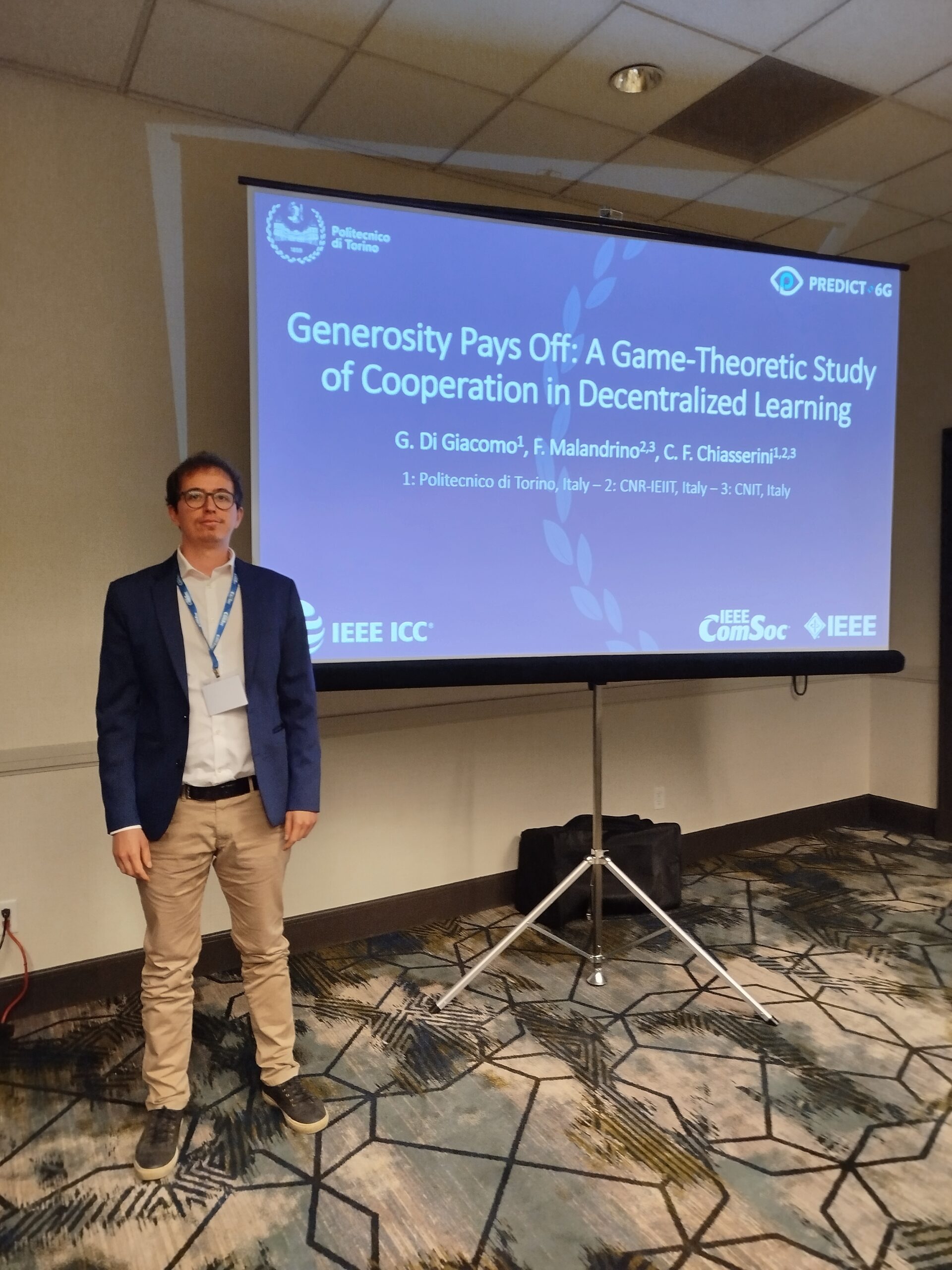
The IEEE International Conference on Communications (ICC) is one of two IEEE Communications Society’s flagship conferences (ICC and Globecom). Each year, close to 2,000 attendees from the industry and academia attend IEEE ICC to learn about the latest research and innovations in communications and networking technology, share ideas and best practices, and collaborate on future projects.
If you want to stay updated about PREDICT-6G, subscribe to our newsletter and follow us on Twitter and LinkedIn!
The “6G Programmable Deterministic Webinar Series: Architectural Enhancements for 6G Programmable and Deterministic Networks”
The “6G Programmable Deterministic Webinar Series'' was launched on the 14 of June 2024, a collaborative initiative between PREDICT-6G, DESIRE6G, and DETERMINISTIC6G. This quarterly series aims to explore the intricate and transformative aspects of these sister projects, featuring expert speakers who will discuss the latest developments and innovations shaping the future of 6G technology. Each session provides in-depth information and fosters key discussions for practitioners and researchers dedicated to the next generation of wireless communications.
The first webinar, titled "Architectural Enhancements for 6G Programmable and Deterministic Networks" featured Peter Szilagyi from Nokia, Chrysa Papagianni from the University of Amsterdam, Joachim Sachs from Ericsson, and Gourav Prateek Sharma from KTH. This was followed by a panel discussion on the topic. The event saw over 120 registrations, with lively participation from attendees during the presentations and the discussion panel.
You can watch the full workshop here.
If you want to stay updated about PREDICT-6G, subscribe to our newsletter and follow us on Twitter and LinkedIn!


